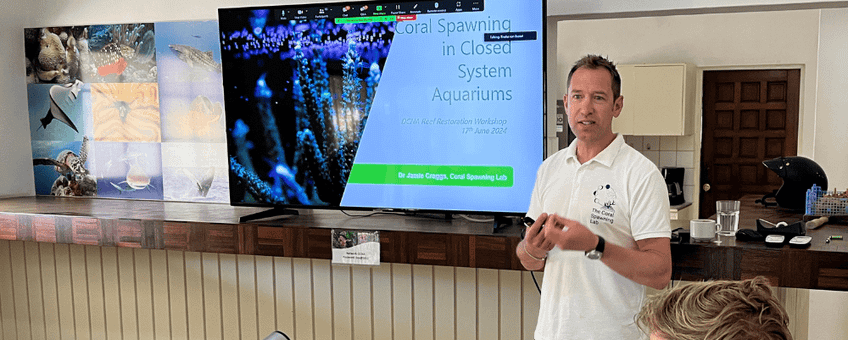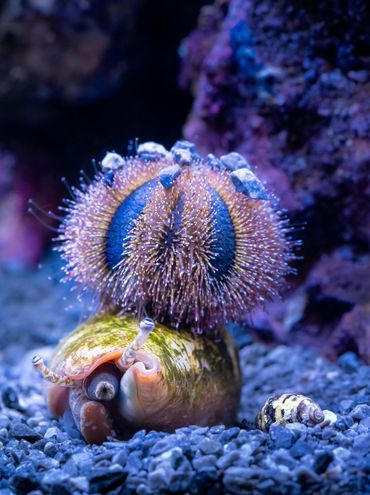
Innovative reef restoration with the Coral Spawning Lab
Dutch Caribbean Nature Alliance (DCNA)Dr. Craggs of the Coral Spawning Lab explained that about 15 percent of hard coral species are brooders, which undergo internal fertilization and release large but fewer larvae (planula). These corals can produce planulae asexually and are relatively easy to manage in aquariums. On the other hand, 85 percent of hard coral species are broadcast spawners, which require reproduction material from two different sexes. These corals rely on external fertilization, often triggered by lunar cycles, leading to synchronous spawning events.
Innovative techniques and findings
A significant part of Dr. Craggs' presentation focused on the experimental approaches to induce spawning in captivity, starting with the initial goal in 2012 of inducing Acropora to spawn. By manipulating environmental factors, such as light, lunar cycles, solar irradiance, and seasonal temperature changes, researchers have successfully induced multiple spawning events each year. These controlled conditions allow for extensive observations and have paved the way for advanced research and selective breeding programs.
Gamete collection and hybridization
The presentation also covered various methods of gamete collection, both in-tank and isolated. Each method has its advantages and challenges, but the ability to perform pairwise crosses in isolated settings has opened new avenues for selective breeding, focusing on traits like thermal resilience. This has led to successful interspecific hybridization, enhancing genetic diversity and resilience of coral populations.
Another groundbreaking concept presented was phase shifting of spawning seasons, which allows for multiple spawning events each year. This technique has significantly increased the availability of gametes for restoration projects. The goal is to spawn and grow corals at an industrial scale, meeting the demands of restoration and research.
Living biobanks and conservation
Dr. Craggs emphasized the importance of living biobanks in conserving the world's most endangered coral species. These biobanks serve as repositories of genetic material, providing a crucial backup to prevent species extinctions.
 Close-up of a Mespilia Globulus in an aquarium (Source: William Warby)
Close-up of a Mespilia Globulus in an aquarium (Source: William Warby)
Co-culture of coral and sea urchins
In his second presentation, Dr. Jamie Craggs explored the benefits of co-culturing corals with sea urchins, specifically focusing on the species globular sea urchin (Mespilia globulus) and the stony coral Acropora millepora. This research demonstrated that co-culturing these organisms can significantly increase post-settlement survival rates of corals. New research highlights the impact of benthic competition on coral survival, identifying the benefits of using sea urchins as micro-herbivores to manage algal and cyanobacterial growth. The study tested various grazing densities and found that higher densities of sea urchins led to improved coral survival and growth rates.
Heterotrophic feeding and thermal resilience
Dr. Craggs also emphasized the importance of heterotrophic feeding in coral aquaculture. His findings suggest that providing corals with specific diets not only enhances their growth post-settlement, but also boosts their thermal resilience, a critical factor in combating the effects of climate change on coral reefs.
Implications
The DCNA Reef Restoration Workshop was a pivotal event that showcased the collective efforts and innovative strategies in coral reef restoration. Dr. Jamie Craggs' presentations on coral spawning in closed system aquariums and co-culturing with sea urchins underscored the potential of these techniques to enhance restoration practices. By promoting collaboration and knowledge sharing, the workshop has set the stage for future advancements in safeguarding our coral reefs.
More information
- Watch is talk on coral spawning in closed system aquariums.
- You can also view his presentation on co-culture of coral and sea urchins.
- Or watch an interview with Dutch Caribbean TV.
- This workshop is funded by the Ministry of Agriculture, Fisheries, Food Security and Nature and supported by the Dutch Postcode Lottery. Craggs' participation in the workshop is sponsored by Diergaarde Blijdorp.
- Stay tuned for more articles in this coral reef restoration series, where we will delve deeper into the topics discussed during the workshop, highlighting the critical work being done to preserve these vital marine ecosystems.
Text: Dutch Caribbean Nature Alliance
Photo's: Arno Verhoeven (lead photo: Dr. Jamie Craggs of the Coral Spawning Lab); William Warby
